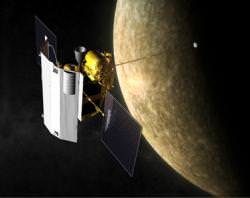Today, the MESSENGER spacecraft will perform a significant task in its mission by making its first flyby of Mercury (see more info below). Additionally, other spacecraft that are out doing their jobs in various locations of our solar system will have significant mission events occur in 2008. Let’s take a look at the big events coming up this year.
January 14: MESSENGER Flyby of Mercury
Messenger, the MEercury Surface Space ENvironment GEochemistry and Ranging spacecraft, will be the first spacecraft to visit Mercury in almost 33 years. It will explore and take close-up images of parts of the planet that we’ve never seen before. This is the first of three flybys of Mercury the spacecraft will take before settling into orbit in 2011. MESSENGER’s cameras and other instruments will collect more than 1,200 images and make other observations during this approach, encounter and departure. The closest approach of the flyby will occur at 19:04:42 UTC (2:04:42 EST), but mission managers said pictures from the event may not be released for up to a week.
March 12: Cassini flies through the plume of Enceladus’ geyser
The Cassini spacecraft will fly extremely close to Saturn’s moon Enceladus at an altitude of only 23 km (14 mi), and actually fly through the plume of an active geyser on the moon’s south pole. How such a cold moon could host an area warm enough to have erupting water vapor is a mystery. Scientists are pondering if Enceladus has active ice volcanism, and if so, is it due to ice sublimating, like a comet, or due to a different mechanism, like boiling water as in Old Faithful at Yellowstone. This flyby will help answer those questions.
Cassini will also have several relatively close flybys this year of the moon Titan. The flybys will occur on Feb. 22, March 25, and May 12.
May 25: Phoenix lands on Mars
Phoenix will land in the north polar region of Mars and will help characterize the climate and geology of the Red Planet, as well as possibly determine if live ever arose on Mars. Pursuing NASA’s “Follow the Water” strategy, the lander will dig through soil to reach water ice with its robotic arm and perform numerous scientific experiments. Phoenix launched on Aug. 4, 2007. University of Arizona’s Phoenix page
September 5: Rosetta flyby of Asteroid Steins
The Rosetta spacecraft is on its way to orbit comet 67P Churyumov-Gerasimenko in 2014, but in the meantime it will pass by Asteroid 2867 Steins. During the flyby, Rosetta will study Steins to determine and characterize the asteroid’s surface composition and morphology. Asteroid Steins is roughly 10 km in diameter.


Cassini flies by Enceladus at only 14 miles!??! That is REALLY cutting it close! I hope they don’t screw it up. Cassini is the best mission (among many) that is out there.